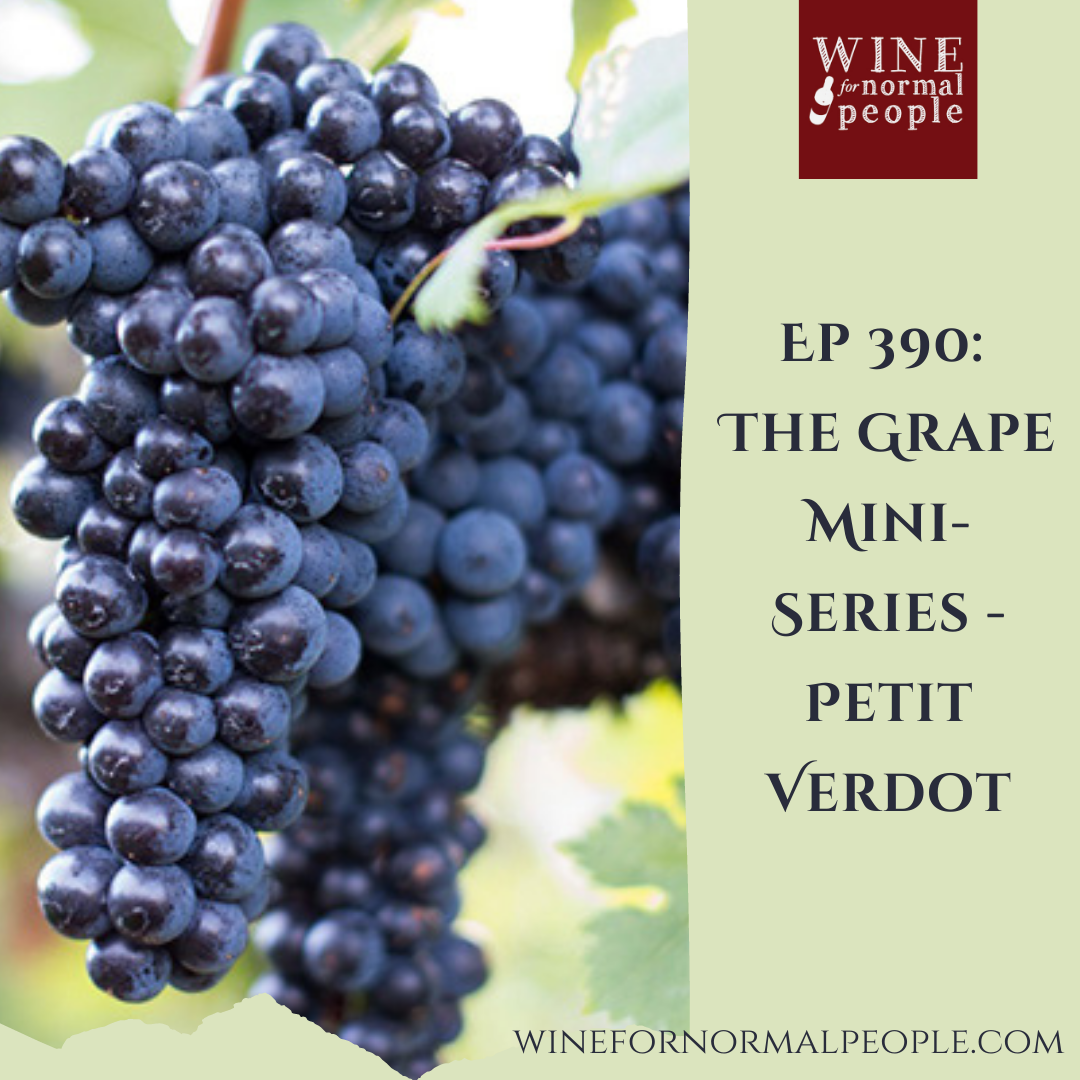Ep 390: The Grape Miniseries -- Petit Verdot

b'
Petit Verdot is often the secret weapon in a blend -- providing unique aromas and flavors plus acidity and tannin. In this show, we discuss this essential grape and the vital role it plays in wines around the world.
What is Petit Verdot?
- The name means \\u201clittle green one\\u201d, since it\'s hard to ripen, the berries remain green when other grapes are ready to harvest
- The grape is used in Bordeaux blends but sometimes made as a varietal wine
- Petit Verdot ripens later than other varieties and is used for tannin, color and flavor, gives structure to mid palate
 Photo: Virginia Wine
Photo: Virginia Wine
Origins: Around in Bordeaux before Cabernet Sauvignon
- Could have been brought to Bordeaux by Romans
- Probably from Southwest France around the Pyr\\xe9n\\xe9es but gained recognition in the M\\xe9doc and Graves (on the Left Bank of Bordeaux)
- Plantings shrunk after phylloxera and the big 1956 frost in Bordeaux
- Petit Verdot was uprooted to be replaced in Bordeaux with Merlot and Cabernet Sauvignon
- Now \\u2013 more being planted, can withstand heat and drought
\\xa0
The grape:
- Small, thick-skinned berries that look almost black because of high anthocyanins -- lots of color and tannin!
- Early budding, late ripening -sometimes too late for the Bordeaux climate but that is changing (more similar to Cabernet Sauvignon than Merlot in the vineyards
\\xa0
In the vineyard:
- Best on warm, well-drained, gravel-based soils\\xa0
- Canopy management to maximize sun exposure is important
- If the weather does not cooperate in the spring during flowering, the fruit will not ripen well\\xa0
- Sensitive to water stress
Winemaking:
- Even in small amounts (0.5%!), Petit Verdot can make a big difference
- Most winemakers will age these wines in oak, fostering undercurrents of vanilla
\\xa0
Aromas/flavors:
- Pencil shavings, violet, black fruit, spice, tannins, acidity
- Very acidic if not fully ripe but can be elegant and refreshing if it\\u2019s ripe
- Cool climate: Dried herbs (sage, thyme), blueberry, blackberry with violet, leathery, pencil shavings
- Warm climate: Jammy, spicy, dark fruit, full-bodied, decent acidity, high tannin
\\xa0
Old World
France
- Almost all Petit Verdot in France is in the M\\xe9doc of Bordeaux
- Big proportions are in: Chateau Margaux, Chateau Palmer, Chateau Pichon Lalande (Pauillac), Chateau Lagrange in St. Julien, Chateau La Lagune, Chateau Siran in Margaux
Italy
- Primarily in Tuscany in the Maremma Toscana DOC (we mention the PV by Podere San Cristoforo), and in Sicily in the Menfi and Sicilia DOCs. Some in Lazio and Puglia
Other Old World Places:
- Spain:\\xa0Petit Verdot grow in warmer areas like Castilla y Leon, Jumilla, La Mancha, Alicante, M\\xe9ntrida DO
- Portugal: Success in Alentejo
- Found in Turkey, Israel
\\xa0
New World
United States
- Virginia: Often blended with Merlot of Cab Franc

- Needs free-draining soils (gravel is best) and high heat
- We get a firsthand account of PV from Elizabeth Smith of Afton Mountain, who makes outstanding wines.
- California: Napa, Sonoma, Paso Robles, Lodi, Central Valley used in Meritage/blends often, with a few boutique standalones
- Washington State:\\xa0PV is grown and made in Columbia Valley, Walla Walla, Yakima, Red Mountain
- Other Places: Planted in Arizona, Colorado, Oregon, Texas, Michigan, PA, Maryland, New York, and more
\\xa0
Canada:
- Okanagan Valley of BC, Niagara Peninsula in Canada
\\xa0
Australia
- Used to make big bodied, lots of floral and dark fruit flavor single varietal wines. The grape has good acidity and tannin that will age for several years
- Ripens very late, often weeks or a month later than Shiraz
- Regions:\\xa0
- More bulk wine: Riverland, Murray Valley, Riverina, region is home to Australia\\u2019s largest plantings of Petit Verdot (which maintains acidity, even in heat)
- Better areas: McLaren Vale, Langhorne Creek, Barossa, Clare Valley, Coonawarra, and the Limestone Coast.
\\xa0
\\xa0
Argentina
- Every region from Patagonia to Calcahqu\\xed but mostly in Mendoza -70% or more is there. Verdot has good results in Bordeaux style blends
Other South America: Peru, Chile, Uruguay \\u2013 in blends and a varietal wine
\\xa0
South Africa:
- Mainly in Bordeaux blends and as a varietal too
\\xa0
Food Pairings with PV:
- Grilled or roasted red meat or hearty vegetables
- Spicy pork and spicy foods in general \\u2013 Latin American spices
____________________________________________________________
Thanks for our sponsors this week:
Wine Access:\\xa0Access to the best wines for the best prices! For 15% off your next order, go to\\xa0www.wineaccess.com/normal
\\xa0
To become a member of Patreon go to\\xa0www.patreon.com/winefornormalpeople
\\xa0
To register for an AWESOME, LIVE WFNP class with Elizabeth go to:\\xa0www.winefornormalpeople.com/classes
\\xa0
'